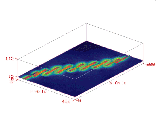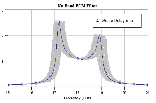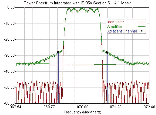A Multilevel Design Environment for Wireless System Development
Applied Wave Research Inc. (AWR)
El Segundo, CA
Simulation techniques have been in use for many years to support the design and evaluation of RF and microwave systems. During the past three decades, computer-aided engineering (CAE) techniques have matured and are now an integral part of both the circuit- and system-level design processes. The impetus for the increased use of CAE techniques has stemmed largely from the combination of reduced design cycles and the growing intractability of the more complex systems now being fielded. Both systems and signal environments have grown more complicated with the advent of digital communication techniques such as CDMA, which has placed additional pressures on circuit and system designers.
True Multilevel Simulation
The Microwave Office Wireless Design Suite (WDS) provides a new level of realism when predicting practical system performance through the use of CAE techniques. RF circuit designers now understand the need to test subsystems such as amplifiers under real-world operating conditions. It is necessary to answer questions like “How do amplifier nonlinearities affect spectral regrowth?” and “How do mixer spurs affect bit error rates (BER)?” The WDS allows RF/microwave engineers to both answer these questions during the conceptual development process and refine the simulations as transistor-level simulations or measurements become available.
The WDS provides an optimal integration of modeling and simulation techniques for both circuit-level and behavioral-level (sometimes called system-level) evaluation. Complex-envelope representation allows the efficient end-to-end simulation of complete communication links at the system level. Measures of performance include BER, detailed spectral analysis and many other outputs used for digital communication and other signal processing systems. The simulation of detailed circuit models is fully embedded into the behavioral system simulation. New techniques allow the overall simulation to efficiently integrate data from EM, linear and nonlinear circuit models with the system-level simulation. This capability allows the user to realistically assess the statistical performance of real circuits using Monte Carlo techniques. Statistical measures of performance like BER may be collected for systems employing transistor-level and even EM-based models.
Capabilities and Models
The integrated system/circuit solution represents the culmination of years of combined development effort between AWR and ICUCOM Corp., Troy, NY. The two companies collaborated to build an object-oriented solution from the ground up by leveraging advances in computer science and engineering. This comprehensive CAE solution combines the acclaimed architecture and user interface of the Microwave Office 2000 product with a next-generation version of ICUCOM’s Advanced Communication Link Analysis and Design Environment (ACOLADE) system simulation technology.
The new ACOLADE incorporates years of research and development in system-level simulation technology with one of the largest sets of functional models in the electronic design automation industry (more than 700). This enormous collection of models includes application-specific libraries supporting all popular communication standards, such as GSM, CDMA, 3G, Global Positioning System, digital video broadcast, high definition television and many others. In addition, ACOLADE’s libraries have been validated over many years in conjunction with significant system development efforts. For example, the wideband CDMA (W-CDMA) library includes sophisticated system models such as Turbo encoders/decoders and all-digital RAKE receivers with advanced features such as multi-user detection.
ICUCOM was the first company to offer a comprehensive library for the simulation of the IS-95a CDMA communication standard and has maintained an unchallenged leadership position in the simulation of W-CDMA systems. The WDS GSM library incorporates full support for the Enhanced Data Rate for GSM Evolution and General Packet Radio Service standards. Full vocoder support for both GSM and CDMA systems is available, including an end-to-end speech play-through capability.
Since the WDS focuses directly on communication link modeling, a comprehensive set of channel models are available. Sophisticated models for fading, multipath, jamming and impulse noise are developed at a level of detail necessary for accurate assessment of real-world operating environments. For example, multipath channels have dynamically varying path delays, providing a testbed for assessment of dynamic channel sounding algorithms and RAKE finger assignment/tracking schemes.
The Microwave Office WDS interfaces to popular test equipment, accepting time domain data directly from arbitrary waveform generators and other common equipment. Measured noise spectra from elements such as frequency synthesizers may be imported to assess the impact of imperfect phase references. WDS also can be used to synthesize waveforms for export as a stimulus for real-world hardware. In addition, Microwave Office WDS interfaces to popular products such as Matlab. Users of this tool may run co-simulations with WDS or compile M-files directly into C++ code for direct and efficient implementation.
Examples
 Figure 1 shows a two-hop satellite link employing Reed-Solomon and convolutional coding. A solid-state high power amplifier (HPA) amplifies an offset quadrature phase-shift keying signal on the uplink, and a traveling-wave-tube amplifier (TWTA) provides the gain for the downlink. The HPA is modeled at the circuit level, as the circuit diagram illustrates. BER is calculated for both coded and uncoded operation and plotted in conjunction with analytical bounds. The TWTA is modeled based on the manufacturer’s supplied AM/AM and AM/PM characteristics. Laboratory measurements of these characteristics may be imported from popular spreadsheets.
Figure 1 shows a two-hop satellite link employing Reed-Solomon and convolutional coding. A solid-state high power amplifier (HPA) amplifies an offset quadrature phase-shift keying signal on the uplink, and a traveling-wave-tube amplifier (TWTA) provides the gain for the downlink. The HPA is modeled at the circuit level, as the circuit diagram illustrates. BER is calculated for both coded and uncoded operation and plotted in conjunction with analytical bounds. The TWTA is modeled based on the manufacturer’s supplied AM/AM and AM/PM characteristics. Laboratory measurements of these characteristics may be imported from popular spreadsheets.
 The next two examples illustrate the results of analyzing the physical geometry and layout of a Ku-band edge-coupled microstrip filter used in the satellite communications example. Figure 2 shows the actual E fields surrounding the filter and Figure 3 shows the statistical variations that occur when the effect of etching tolerances and substrate variations is simulated on the group delay.
The next two examples illustrate the results of analyzing the physical geometry and layout of a Ku-band edge-coupled microstrip filter used in the satellite communications example. Figure 2 shows the actual E fields surrounding the filter and Figure 3 shows the statistical variations that occur when the effect of etching tolerances and substrate variations is simulated on the group delay.
 One of the problems encountered when designing with practical analog filters is nonlinear phase response as a function of frequency. Since group delay is the derivative of the phase response, this result is equivalent to a nonconstant group delay. When different delays are associated with different frequencies, pulse distortion can occur. In the systems analysis, the response of the EM filter is simulated with the input from the digital encoders such that the nonconstant group delay of the EM filter is apparent in the I/Q constellation diagrams.
One of the problems encountered when designing with practical analog filters is nonlinear phase response as a function of frequency. Since group delay is the derivative of the phase response, this result is equivalent to a nonconstant group delay. When different delays are associated with different frequencies, pulse distortion can occur. In the systems analysis, the response of the EM filter is simulated with the input from the digital encoders such that the nonconstant group delay of the EM filter is apparent in the I/Q constellation diagrams.
 Adjacent-channel power ratio (ACPR) has become an increasingly important measure of performance in wireless system design and development. Measures of performance such as BER characterize the effect of nonideal RF subsystems on the intended receiver’s operation. ACPR, on the other hand, characterizes a transmitter’s impact on other users occupying nearby frequency bands. Figure 4 shows an ACPR measurement made on a CDMA signal. Spectral analysis has been performed on both the ideal modulator output and the nonlinear amplifier output. The spectral regrowth due to the nonlinear amplifier is evident. The spectral plot is zoomed to display a frequency band of interest.
Adjacent-channel power ratio (ACPR) has become an increasingly important measure of performance in wireless system design and development. Measures of performance such as BER characterize the effect of nonideal RF subsystems on the intended receiver’s operation. ACPR, on the other hand, characterizes a transmitter’s impact on other users occupying nearby frequency bands. Figure 4 shows an ACPR measurement made on a CDMA signal. Spectral analysis has been performed on both the ideal modulator output and the nonlinear amplifier output. The spectral regrowth due to the nonlinear amplifier is evident. The spectral plot is zoomed to display a frequency band of interest.
The IS-95a air interface standard requires that the spread spectrum signal spectrum be below a specific level in a 30 kHz notch located just outside the allocated channel bandwidth. The mask corresponding to this specification is used to integrate the spectrum over this frequency region to calculate the ACPR value. The WDS incorporates a powerful spectral analysis capability that allows accurate spectral estimates to be calculated. Sophisticated digital techniques are employed to calculate long-term spectral averages of signals under observation. Powerful convergence techniques are employed to ensure arbitrary accuracy of ACPR and other spectral measurements. The actual samples of the digital spectral mask are shown to illustrate the fact that the spectrum is actually a digital spectrum. In this case, the spectral plots illustrate an accumulating average, which has been taken over 200 time windows. Results from system-level analyses can be presented in concrete units (for example, megahertz or kilohertz) that are familiar to hardware designers as opposed to arcane normalized units of time/frequency.
Conclusion
The Microwave Office 2000 design environment has been extended from EM and circuit-level simulation and now makes it possible to combine higher levels of abstraction in a more meaningful way. As opposed to previous total solutions, the Microwave Office WDS offers a truly integrated environment, allowing the labors of system and hardware engineers to flow together in a harmonious way. Combined behavioral- and circuit-level modeling promises to allow complex next-generation wireless systems to be designed in record time. Additional information may be obtained from the company’s Web site at www.mwoffice.com.
Applied Wave Research Inc. (AWR), El Segundo, CA (310) 726-3000.
